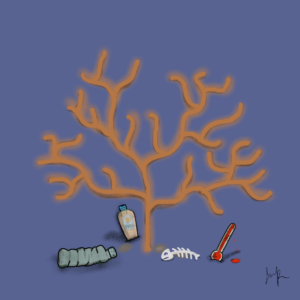
Illustrated by Justin Chan
The ocean, a realm of mystery and wonder, hides countless secrets beneath its shimmering surface. Among the many captivating phenomena lies bioluminescence, a natural light display produced by various marine organisms. From the glow of fireflies to the mystery of deep-sea marine life, bioluminescence continues to captivate marine aquatics researchers, offering both scientific intrigue and beauty.
Beneath the beauty, however, lies an intricate biochemical process that involves the conversion of chemical energy into light (NOAA). When luciferase enzymes interact with a light-emitting molecule called luciferin in the presence of oxygen and other necessary cofactors, the result is a stunning, often blue or green glow that can be seen in the darkest depths of the ocean (Petruzzello).
Despite just the visual appeal, bioluminescence serves important functions for marine organisms. In the deep ocean, where light is close to none, bioluminescence becomes a tool for survival. Its utilities span from communication to predation and even to reproduction. Some species, such as the flashlight fish, have even evolved light-producing organs called photophores. Like a flashlight, the fish are able to direct the light they emit and even control the intensity, serving mainly as a form of communication and predation deterrence. The cookie-cutter shark, on the other hand, lures various prey to the underside of their bellies, which glow with bioluminescence. When prey such as squids get within range, the cookie-cutter takes a quick bite. On a more intimate side, the common firefly employs it to find potential partners, creating a mesmerizing dance of light on warm summer nights (TOPT).
While bioluminescence continues to entrap the world in its beauty and intricacies, man-made pollutants have started to affect even those far below sea level. Pollution, habitat destruction, and climate change can disrupt the delicate balance of marine life and, in turn, affect bioluminescence. On the water, blinding lights from commercial shipping, fishing, and large oil rigs dish out startling levels of light pollution. And as Doctor Vanessa Pirotta writes for Phys Org, the rising levels of light pollution in the ocean can alter the “dynamics of energy transfer efficiency between marine species”(Pirotta).
From the depths of the vast seas to the shallows of tropical shores, these organisms paint the marine canvas with bountiful fluorescent lights. Understanding the phenomena of bioluminescence and the creatures’ role in aquatics not only lifts the fog on these extraordinary creatures but serves as a benchmark for human progress in the fight against human-made pollutants. Nonetheless, the allure of bioluminescence continues to remind us of the beauty that lies beneath the dark blue.
Works Cited
“Luciferase | Definition, Bioluminescence, Enzyme, Reaction, & Facts.” Britannica, 29 June 2023, https://www.britannica.com/science/luciferase. Accessed 16 August 2023.
NOAA. “What is bioluminescence?” National Ocean Service, https://oceanservice.noaa.gov/facts/biolum.html. Accessed 16 August 2023.
Pirotta, Vanessa. “Sparkling dolphins swim off our coast, but humans threaten these natural light shows.” Phys.org, 23 April 2020, https://phys.org/news/2020-04-dolphins-coast-humans-threaten-natural.html. Accessed 16 August 2023.
TOPT. “Bioluminescence | Smithsonian Ocean.” Smithsonian Ocean, 30 April 2018, https://ocean.si.edu/ocean-life/fish/bioluminescence. Accessed 16 August 2023.
The views and opinions expressed are those of the authors and do not necessarily reflect nor represent the Earth Chronicles and its editorial board.









